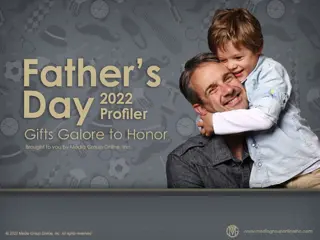Insights into Men's Shopping Trends and Behavior Amid Market Challenges
The menswear market faced a substantial decline in 2020, with a notable drop in formalwear sales. Consumers gravitated towards comfortable and casual clothing due to the shift to remote work. Online shopping emerged as a dominant trend, with men opting for convenience and looking for deals through loyalty programs. Understanding consumer activities and interests is crucial for effective marketing strategies in the evolving men's fashion landscape.
Download Presentation

Please find below an Image/Link to download the presentation.
The content on the website is provided AS IS for your information and personal use only. It may not be sold, licensed, or shared on other websites without obtaining consent from the author.If you encounter any issues during the download, it is possible that the publisher has removed the file from their server.
You are allowed to download the files provided on this website for personal or commercial use, subject to the condition that they are used lawfully. All files are the property of their respective owners.
The content on the website is provided AS IS for your information and personal use only. It may not be sold, licensed, or shared on other websites without obtaining consent from the author.
E N D
Presentation Transcript
Wardrobes on Hold The menswear market, much like womenswear, experienced a substantial decline during 2020. The NPD Group reported total menswear sales decreased 18% YOY and the dress sub-category (suits, dress pants and shirts) decreased more than 40%. The market was so bad the U.S. Census Bureau didn t report sales at men s clothing stores (NAICS 44811) for October and November 2020 because of insufficient data. Even the most recent period of Census Bureau data revealed sales at men s clothing stores during the first five months of 2021 ($2.66 billion) increased 51.1% from 2020 ($1.76 billion), but was still 27.1% less than 2019 ($3.65 billion).
Mens Shopping Trends As in the womenswear market, men were choosing comfortable and often very casual clothing during 2020 and into 2021 with so many working from home. The substantial decline in formal occasions, especially weddings, was another trend stifling the market. Those participating in an October 2020 daVinci Payments survey said their family and friends (word-of-mouth) influenced them the most when choosing a product to buy. The daVinci Payments survey results also show men are not spendthrifts, as the respondents listed price as the most important factor when making a purchase, followed by quality, availability, brand name, safety and store/seller.
Online Shopping Rules The daVinci Payments survey is very clear: men are online and mobile shoppers, as 70% said most of their shopping occurs online, 66% do most of it via their smartphone and 61% use contactless technology to pay for in-store purchases. Unsurprisingly, 77% are Amazon Prime members and 65% said that is where they make most of their online purchases. Amazon was, therefore, listed first of where men learn about brands, followed by Google, online stores, friends and family and TV. Men don t shop on resell and consignment sites as much as women, but 67% of those responding to the daVinci Payments survey said they do and, unsurprisingly, the youngest men are those who shop a reseller the most.
The Active World of Men To reach today s sophisticated consumers effectively, it s often just as important to understand their activities and interests as much as their shopping media habits, which can reveal beneficial promotional and cross-sell opportunities. Analyzing data from the same five representative market surveys from The Media Audit indicates cooking is the #1 activity among men 18+ during the past four weeks who purchased menswear in a local store and online, exceeding 50% in 4 of the 5 markets. Jogging, running and walking were second, ranging from 29.7% in Springfield, MA to 43.3% in Seattle-Tacoma. Hiking was third in four of the five markets, ranging from 26.8% in Phoenix to 16.3% in Toledo.
Loyalty Programs and Rewards Loyalty programs appear to be very important to men as, according to the daVinci Payments survey, 83% would be attracted to a brand offering one compared to a brand without a loyalty program. Almost half (49%) of survey respondents said prepaid that can be spent anywhere was their #1 reward payment preference, followed by gift card for select retailers 31%, check 13% and special savings offers with expiration 7%. Apparel was the second category (49%) for which those participating in a 2021 Clarus Commerce survey would be willing to pay a fee for a premium loyalty program. (Keep in mind almost as many women shop for menswear as men).
Lessons from Tailored Brands The trend of more casual wear in the workplace, even in the C-suite, during the past few years, was a primary factor of the 2020 bankruptcy of Tailored Brands (Men s Warehouse, Jos. A. Bank, Moores Clothing for Men and K&G Fashion Superstore). The steep decline in menswear sales during the pandemic exacerbated that trend. Tailored Brands symbolizes the many challenges of the menswear market as the casual wear trend is expected to continue and more purchases of men s apparel move online. To become more relevant in the digital age, Men s Warehouse has expanded the use of Contactless Fit by Bold Metrics from just its tuxedo rental sector to all customer fittings in more than 650 stores during 2021. The technology has reduced exchanges by 27.4%.
Advertising Strategies With the surge in the delta variant of the COVID-19 virus, menswear stores will likely have to offer both the casual wear popular during 2020 and a return to workplace apparel, which provides an opportunity to promote a discount for one type when purchasing the other. Menswear retailers, whether national, regional or local, are now compelled to sell online in some form since such a large percentage of men shop online. Directing consumers to online-only specials via traditional media ad messages is a necessary strategy. With the information on the bottom of page 2 of the Profiler, menswear retailers can create and advertise promotions based on men s favorite activities: offering a cookbook or jogging and hiking accessories with a qualifying purchase.
New Media Strategies Men are attracted to brands and retailers with loyalty programs and more of them are willing to pay for a premium program. They can use social media to post regular content, including short videos, about their loyalty programs and incentivize consumers to register. The table at the bottom of page 2 of the Profiler, showing men who are fans of the major professional sports, provides retailers with another interest with which to engage with consumers. Ask them to share in a short video their favorite sports-viewing attire. The sustainability data on page 4 of the Profiler indicates menswear retailers will find it beneficial to show their support for these issues as well as diversity and inclusiveness to capture and retain younger consumers who can be long-term customers.























